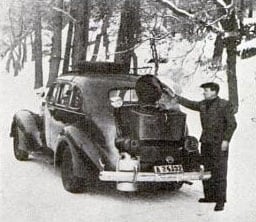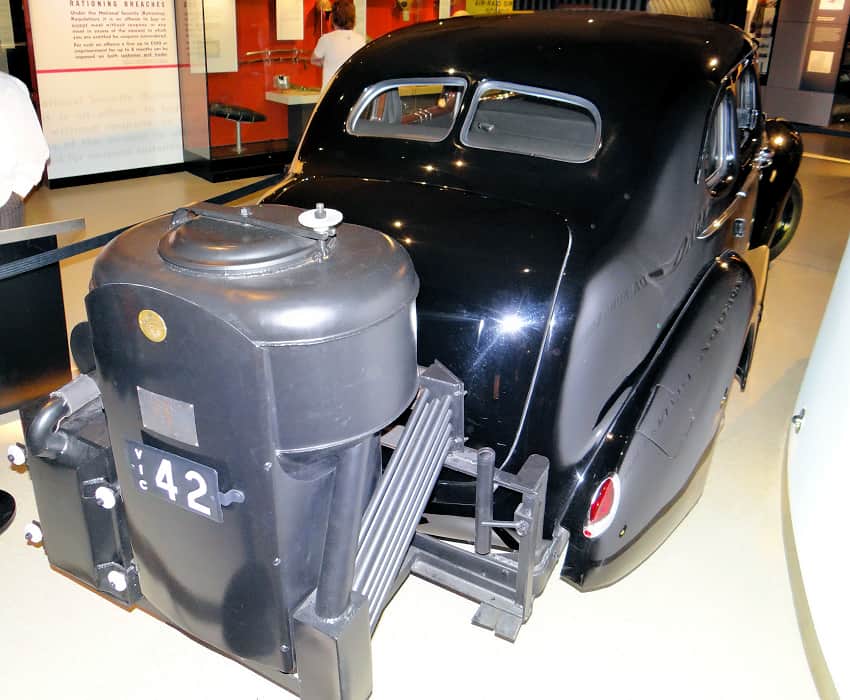Studebaker Charcoal Burner
Racing Cars Burn Charcoal in 250 Mile Swedish Event

“At the finish line of a 250 mile automobile race the other day the checkered flag waved down a strange-looking winner. Strange, at least to Americans, for it was a charcoal burner. The event was the Uppland race in Sweden. Where, as in most of wartime Europe, gasoline is precious and substitutes are used in automobiles. On the back of the winning car, a Studebaker, was mounted the charcoal gas generator. From which the gas driven off during incomplete combustion is fed to the cylinders. About 12 pounds of charcoal are the equivalent of a gallon of gasoline. There is a loss of about 30 precent in efficiency as compared with gasoline”. Article from September 1941 in Popular Mechanics.
It is also interesting to note that the Studebaker Charcoal Burner trucks formed part of the Russian fleet of heavy trucks in 1945 (from Planned Invasion of Japan, 1945: The Siberian Weather Advantage, Hatten Schuyler Yoder).
From Nanango to Cooktown
In the book From Nanango to Cooktown, Lennie Wallace tells how gas producers operated during the second World War. “Strange contrivances, charcoal burners or gas producers, began to appear on some cars. Usually, an apparatus which burnt charcoal was attached or welded to the rear bumper and the ‘gas’ produced was stored in a balloonlike sac on the car’s roof. From there, the gas was somehow taken to the motor as fuel. It did work. The cars drove sedately along the roads but the clouds of stinking black smoke from their exhausts were truly remarkable. Kurt Johannsen, writing in his book A Son of The Red Centre recalls the gas-producer he made for his 1928 Studebaker car. He could easily drive a mile on one and a half pounds of wood. (approximately, as he wrote, a kilogram per kilometre on a three ton vehicle).
The Studebaker travels 8 miles (13km) on burning a wooden beer crate that holds five dozen bottles. Kurt proved it by driving from Tennant’s Creek pub to the Telegraph Station, top speed of 105km per hour and winning a five pound ($10) bet.”
The picture at the top of the page is a 1940 Studebaker Commander Sedan with gas producer from the war years.
The Basics Studebaker Charcoal Burner
In 1941, Studebaker took a pioneering step in the field of charcoal burning and introduced their innovative, space-saving Charcoal Burner. This sleek, compact gasifier quickly became one of the most popular designs for small-scale charcoal production due to its efficient design and ease of operation.
The Charcoal Burner burns charcoal briquettes or pellets inside an insulated chamber. Restricting oxygen produces lower temperatures and higher thermal efficiency. A steady flow of hot air through the burner, the air intake valve is adjustable, allowing users to adjust the heat output accordingly. Exhaust fumes flow upward from the top through a flue tube, dissipating heat into the atmosphere.
Designed with safety in mind, Studebaker’s Charcoal Burner features insulated housing to prevent overheating. An integrated thermometer closely monitors burner temperature. In addition, it came equipped with an emergency shutoff switch should things get too hot. Studebaker opts for a stainless steel construction to protect against rusting and corrosion of mechanical parts in other designs.
In terms of performance and reliability, Studebaker’s Charcoal Burner was one of its kind. It provides users with consistent heat output as well as long-term durability. Furthermore, its lightweight design make it easy to transport from one place to another – perfect as a portable gasifier wherever needed. Its versatility and dependability, the Studebaker’s Charcoal Burner remains one of the most popular designs for small-scale charcoal production today.

